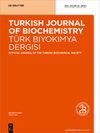Importance of HbA1c and Fructosamine As A Marker Of Glycemic Control and Evaluation Of Some Biochemical Parameters During Pregnancy
IF 0.7
4区 生物学
Q4 BIOCHEMISTRY & MOLECULAR BIOLOGY
Turkish Journal of Biochemistry-turk Biyokimya Dergisi
Pub Date : 2014-01-01
DOI:10.5505/TJB.2014.15238
引用次数: 2
Abstract
Objective: Controlling and monitoring the diabetes during pregnancy, because of the malformation, macrosomia and other complications is especially important. Our study is designed to investigate the reliability of the two most commonly used parameter is the hemoglobin A1c (HbA1c) and fructosamine during pregnancy. Also among our study group, serum total protein, albumin, vitamin B12, folic acid, glucose, insulin, ferritin and hemoglobin data were evaluated. Methods: The study groups are pregnant women (n=252; age mean: 27,761± 5/year) and control group (n=28; age mean: 28,61± 5,38/year) who are no additional health problems. Diabetic pregnant women number is 124 (consisted of 10 first trimester, 62 second trimester and 52 third trimester) and nondiabetic pregnant women number is 138 (consisted of 24 first trimester, 32 second trimester and 82 third trimester). All measurement data are obtained from hospital information system. Results: No statistically significant difference in any of the groups for HbA1c. It’s clearly observed that all the significant differences found for fructosamine occur depending on the level of albumin and fructosamine levels decreased progressively during the three trimesters. In our diabetic pregnant women group; although statistically make a difference; mean blood glucose values were below our expectations. Conclusion: Our study is support that fructosamine and HbA1c are unavailable for diagnosis and monitoring the gestational diabetes. However the lack of difference between the groups for levels of fructosamine and HbA1c; and blood glucose levels below our expectations in diabetic pregnant women group can be connected good diabetes control.妊娠期糖化血红蛋白和果糖胺作为血糖控制指标的重要性及一些生化指标的评价
目的:控制和监测妊娠期糖尿病,因其畸形、巨大儿等并发症尤为重要。我们的研究旨在探讨妊娠期间最常用的两个参数是血红蛋白A1c (HbA1c)和果糖胺的可靠性。我们研究组的血清总蛋白、白蛋白、维生素B12、叶酸、葡萄糖、胰岛素、铁蛋白和血红蛋白数据也进行了评估。方法:研究组为孕妇(n=252;平均年龄:27,761±5岁/年),对照组(n=28;平均年龄:28(61±5.38)岁,无其他健康问题。糖尿病孕妇124例(孕早期10例,孕中期62例,孕晚期52例),非糖尿病孕妇138例(孕早期24例,孕中期32例,孕晚期82例)。所有测量数据均来自医院信息系统。结果:各组HbA1c无统计学差异。很明显,果糖胺的所有显著差异都取决于白蛋白的水平,而果糖胺的水平在妊娠三个月期间逐渐下降。在我们的糖尿病孕妇组;虽然统计上有所不同;平均血糖值低于我们的预期。结论:本研究支持果糖胺和HbA1c不能用于妊娠期糖尿病的诊断和监测。然而,各组之间果糖胺和HbA1c水平没有差异;而血糖水平低于我们预期的糖尿病孕妇组可以连接良好的糖尿病控制。
本文章由计算机程序翻译,如有差异,请以英文原文为准。
求助全文
约1分钟内获得全文
求助全文
来源期刊
CiteScore
1.20
自引率
0.00%
发文量
0
审稿时长
6-12 weeks
期刊介绍:
Turkish Journal of Biochemistry (TJB), official journal of Turkish Biochemical Society, is issued electronically every 2 months. The main aim of the journal is to support the research and publishing culture by ensuring that every published manuscript has an added value and thus providing international acceptance of the “readability” of the manuscripts published in the journal.

 求助内容:
求助内容: 应助结果提醒方式:
应助结果提醒方式:


